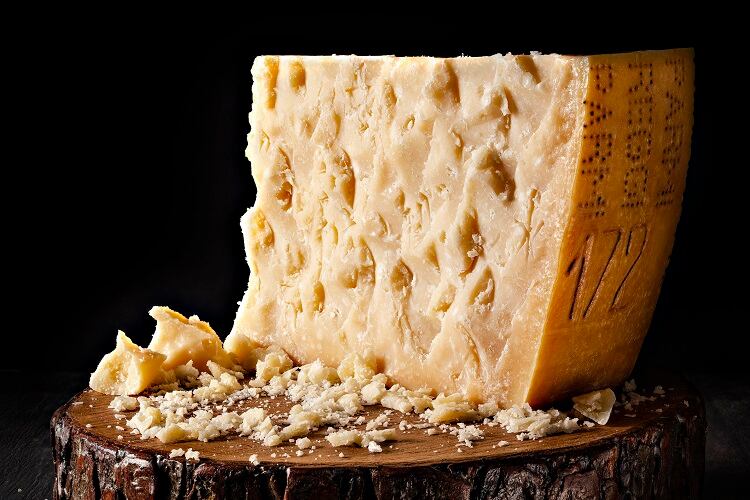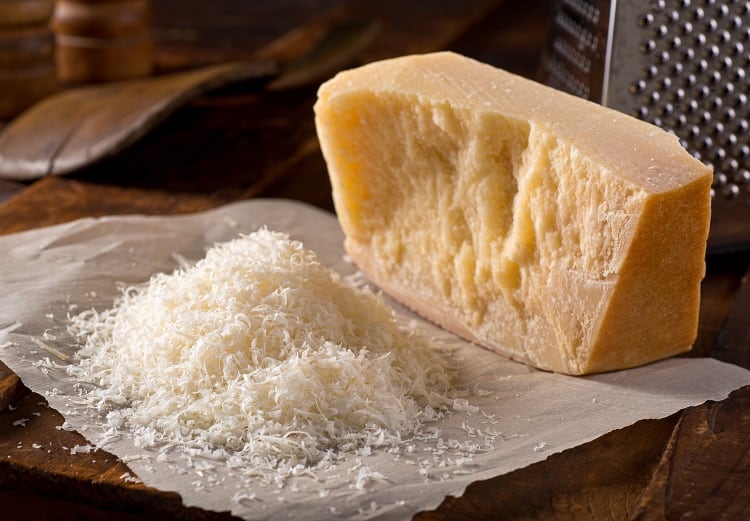Parmesan, or Parmigiano Reggiano as it is known in its native Italy, is a hard, grainy cheese made from raw milk, rennet, and salt.
First produced by Benedictine and Cistercian monks a thousand years ago, today Parmigiano Reggiano is made in the same region in much the same way.
What has changed, significantly, is production volume and global demand. In 2022, a record 64,202 tonnes (production value €1.8bn) of Pamigiano Reggiano was sold in international markets. Highest export volumes were achieved in the US, followed by France and the UK.
With consumer turnover recently hitting an all-time high of €2.9bn, FoodNavigator is investigating what makes Parmigiano Reggiano unique. How is this famed product – considered the ‘king of cheeses’ – made? And what systems do producers of the protected designation of origin (PDO) cheese put in place to protect against potential food fraud?
What makes Parmigiano Reggiano the ‘real deal’?
The cheese has benefited from various forms of protection since the 1950s, but in 1966 Parmigiano Reggiano became one of the first products to be classified a PDO under European law.
Parmigiano Reggiano side streams
Side streams from the Parmigiano Reggiano production process have long been leveraged to limit waste and increase food production.
Butter, for example, was traditionally made from the cream left behind in the evening milking batch. Ricotta, too, can be made from reheating leftover milk.
Any excess whey continues to be fed to pigs in the region for the production of cold cuts, including Parma ham.
According to these PDO specifications, Parmigiano Reggiano is recognised for its distinguishing features: ranging from a fine-grained and flake structure, a fragrant aroma, a delicate taste – ‘flavoursome without being pungent’ – and high solubility and digestibility.
Under EU law, the cheese must be made from raw milk produced from cows in the defined geographical area, from fodder mostly produced (at least 75%) in that same area.
This area comprises the part of the province of Bologna to the left of the River Reno, the part of the province of Mantua to the right of the River Po, and the provinces of Modena, Parma and Reggio Emilia.
The specific physical, chemical and microbiological properties of the milk – which guarantee the specific characteristics of Parmigiano Reggiano – are the result of the diet fed to the dairy cows, which includes a strict ban on the use of silage.
“The reason why Parmigiano Reggiano is a product with a designation of protected origin is linked to bacteria,” explained Ilaria Bertinelli, who comes from a family of Parmigiano Reggiano producers.
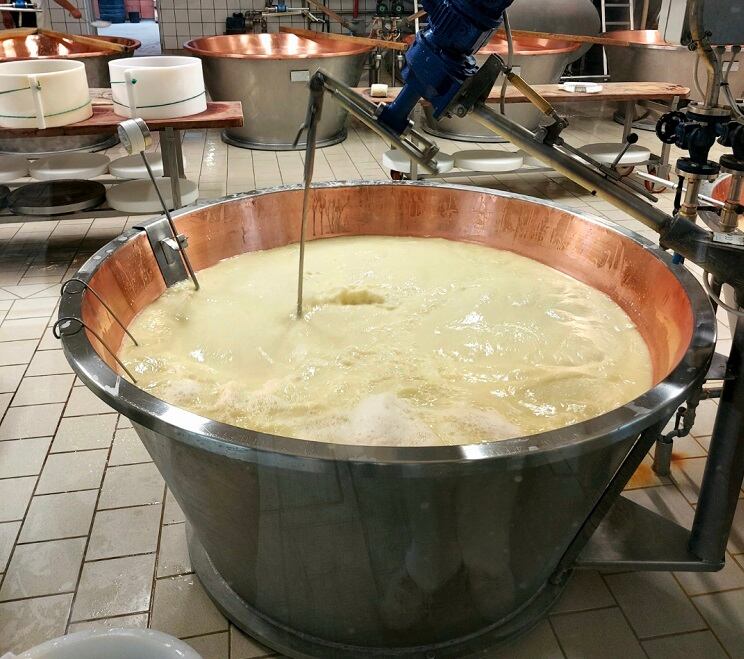
Three lactic acid bacteria crucial to Parmigiano Reggiano production naturally grow on the grass within the defined geographical area. During the production process, many bacteria are eliminated via heating and ageing processes, but these three bacteria survive.
This is also why the production area is bordered by natural boundaries. On the other side of the River Po, for example, where Grana Padana is made, this same combination of bacteria does not exist.
“PDO means that the product and the land cannot be separated,” Bertinelli told us during a recent visit to Parmigiano Reggiano producer Ciaolatte in the Province of Parma. “If you made this cheese in a different part of the world, it would be different.”
Producing Parmigiano Reggiano: From milking to curdling
Ciaolatte is one of the more than 300 dairies producing Parmigiano Reggiano in Italy. Here, as in all producing the famed hard cheese, production begins with milk from two milkings: one in the evening, and one the following morning.
Cheese production begins in copper vats. Each vat produces two wheels of Parmesan per day with a total of 1,100-1,200
The evening milk is left overnight, during which time the cream rises to the surface. In the morning, half of this cream is removed, leaving a low-fat milk which is mixed in copper vats – in equal quantities – with whole milk from the morning milking. Each vat produces two wheels of Parmesan per day from a total of 1,100-1,200L of milk, meaning around 550-600L of raw milk is required to make one wheel of cheese.
Once the reduced-fat and whole milks are combined, the cheesemaker heats the vat to around 36-37˚C, mimicking a cow’s body temperature. During this heating process, the cheesemaker adds the fermented whey starter culture.
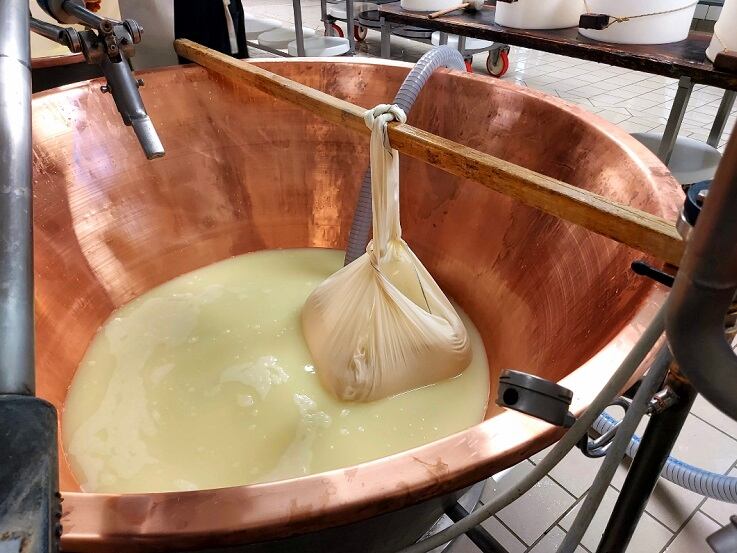
The starter culture is used every day, and added to every day, explained Bertinelli. “It’s completely indigenous, and this process has gone on for thousands of years…It contains all the ferments and microorganisms that will [influence] the characteristics of this cheese from this dairy.”
Depending on its acidity, around 27-30L of starter culture is added per vat. The higher the acidity of the culture (likely due to warmer weather conditions), the less fermented whey is added.
During the heating process, around 20g of rennet – a by-product of the meat processing industry sourced from the stomach of suckling calves – is also added to the milk and whey mixture, which kickstarts the curdling process. Within a period of around 7-8 minutes, the milk transforms into a curd with the texture of a thick yogurt.
It is now time for the cutting process to begin. In cheesemaking, curd is cut into different sizes depending on the type of cheese. The cutting determines the final texture, explained Bertinelli. “The finer the curd, the harder the cheese. For gorgonzola, bigger pieces [of curd] make it creamier.”
In the making or Parmigiano Reggiano, the curd is cut into small particles the size of rice grains to ensure a fine, granular texture in the final product.
From moulding to maturation
Once the curd is sufficiently cut, the cooking process begins, bringing the curd’s temperature up to 51-55˚C. The cheesemakers measure the temperature according to the French-derived Réaumur scale, which displays as around 44-45 on their Réaumur probe.
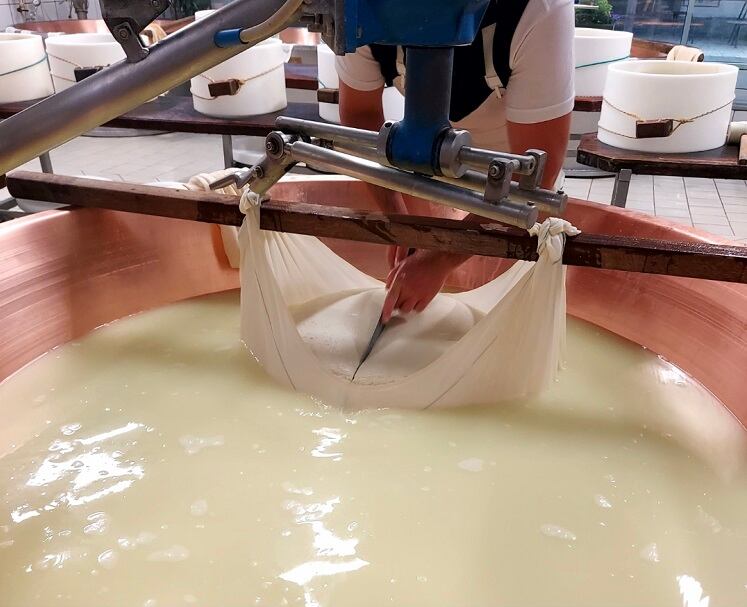
The use of the Réaumur probe in Parmesan cheesemaking dates back to the Middle Ages, when a lot of French monks worked in Parmigiano Reggiano-making Italian monasteries. Use of this temperature scale is extremely rare nowadays, but in Parmesan production, the tradition remains.
The 51-55˚C (or 44-45 Réeamur) temperature is significant, because it below the pasteurisation temperature of 60˚C and above. Parmigiano Reggiano is a raw milk cheese, stressed Bertinelli. The 51-55˚C temperature is also low enough to ensure those three lactic acid bacteria remain alive and active.
After around 6-7 minutes, the curd transforms into cheese. All in all, the cheesemaking process is relatively quick, explained Bertinelli. It takes about 20-25 minutes to transform the milk into curd and into cheese, and then one hour for the cheese ‘grains’ to settle to the bottom of the vat. Of course after that, the process is longer. Once moulded, the cheese is only ready for consumption after between two and seven years.
The settled ‘grains’ on the bottom of the vat seal together to form a ‘cheese mass’, at which point the cheesemakers remove and shape it in moulds. The cheese remains for one day in a straight mould, one night in a plastic ‘matrix’ to imprint information about its production on the rind – including the production month, year, the dairy ID, and intricate Parmigiano Reggiano inscriptions. The following day, the cheese is transferred into stainless steel moulds for two days.
“After three days, the cheese is shaped and ready to be salted,” Bertinelli told FoodNavigator. At this point, the cheese is submerged in a heavily salted brine made with salt sourced from Sicily for a period of 19 days.
After 19 days followed by a quick two-hour stop-off in a warm room, the cheese is ready for maturation.
How does maturation impact taste and texture?
A ‘huge’ difference in taste and texture is observed as cheese ages, explained Ilaria Bertinelli.
Once a cheese is aged past 18 months, ‘little crystals’ begin to form. While many believe these crystals to be salt, they are in fact the amino acid tyroside, a constituent part of the milk protein casein.
The longer the maturation process, the more proteins are broken down. “For people who are intolerant to dairy proteins, they are completely broken down when the cheese is matured 36 months and over. In a 36-month-old cheese, these crystals are very evident.”
A minimum 12-month maturation process must be observed before the cheese can be officially considered Parmigiano Reggiano, but a minimum of 24 months is most commonly observed. During this time, the cheese is brushed and turned upside down – these days by machine – every ten days on average.
According to Parmigiano Reggiano’s PDO specifications, the minimum weight of each wheel is 30kg. But at Ciaolatte, the final product usually weighs between 40-45kg each.
Protecting Parmigiano Reggiano
Producers of Parmigiano Reggiano have long been working to differentiate their production from other, cheaper imitation products.
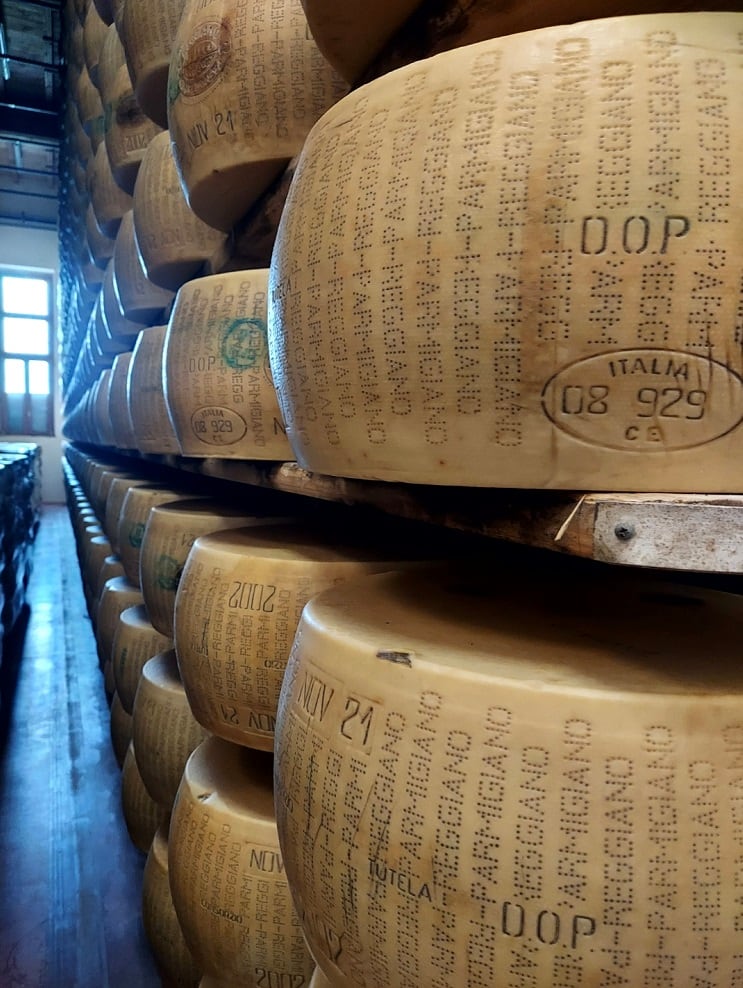
In 1935, dairy farmers joined forces to establish the Consortium of Parmigiano Reggiano. Today, the Consortium is responsible for protecting, monitoring and safeguarding the cheese’s PDO and ensuring ‘that no other product bears names, marks and/or other distinctive marks that could breach’ the PDO or mislead consumers.
It is the Consortium that provides dairies with the bands to mark production details into the rind, and in working to ensure Parmigiano Reggiano’s quality, after one year of cheese maturation the Consortium organises for an inspector to visit each producer. The inspector hammers each wheel of cheese and listens for any kind of sound: if the cheese mass is compact, with no cracks or holes, there is no sound.
At this point, the Consortium brands an oval mark with the words ‘Parmigiano Reggiano Consorzio Tutela’ onto the cheese, which is now officially Parmigiano Reggiano.
If, on the other hand, the cheese does contain tiny holes or cracks less than 5mm in diameter, the Consortium will still brand it as Parmigiano Reggiano, but it will also engrave lines into the rind as a mark that quality may be compromised. The Consortium recommends these cheese be consumed after one year, rather than the minimum two.
Within Parmigiamo Reggiano, as within most premium food products, food fraud does exist. According to the Consortium, the estimated global turnover of counterfeit parmesan stands at around $2bn (€1.85bn).
Aside from providing unique markings and brandings, the Consortium has also partnered worked with digital labels to help improve authenticity and traceability.
Within Europe, however, Parmesan-related food fraud is no longer such a big issue, explained Bertinelli. Thanks to geographical indication laws, the only ‘parmesan’ sold across the EU is Parmigiano Reggiano.
Outside of EU jurisdiction, however, much hard cheese produced outside of Italy is marketed as ‘parmesan’. Bertinelli believes consumers are often misled into believing such a cheese is produced in Italy.
“If you think you’re buying something and instead they give you something else, that is cheating,” she stressed. “Knowing the origin of your product is a consumer’s right.”


